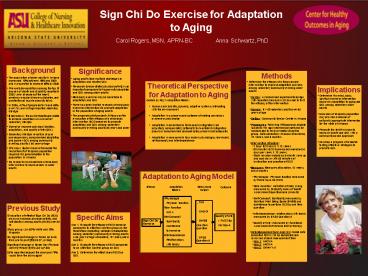Sign Chi Do Exercise for Adaptation to Aging PowerPoint PPT Presentation
1 / 1
Title: Sign Chi Do Exercise for Adaptation to Aging
1
Sign Chi Do Exercise for Adaptation to Aging
Carol Rogers, MSN, APRN-BC Anna
Schwartz, PhD
- Background
- The population of older adults in Arizona
increased 10 between 1990 and 2000 and is
expected to increase 60 by 2050 - Preventable conditions among the top 10 causes of
death and disability reported in 2003 were
diseases of the heart, cerebrovascular diseases,
diabetes, and unintentional injuries (mostly
falls) - In 2005, 47 of people 65 to 74 and 60 over 75
years of age reported sedentary lifestyle - 150 billion the cost of healthcare related to
chronic conditions as a result of sedentary
lifestyle - Exercise improves physical function, adaptation,
and quality of life (QOL) - Sedentary lifestyle results in disuse
consequences, compromised adaptation, and poorer
QOL among community dwelling adults 65 years of
age - Previous studies have not included the
recruitment of Hispanic population required for
generalization to the population in Arizona - No research has examined a mind-body intervention
to improve QOL in older adults
- Significance
- Aging adults face multiple challenges in
adaptation and related QOL - Research demonstrated physical activity is an
important component of successful adaptation and
QOL among older adults - Mind-body exercise may be beneficial to
adaptation and QOL - There has been limited research of mind-body
exercise interventions to promote adaptation in
the population of aging adults - The proposed pilot project will focus on the
evaluation of the efficacy of a mind-body
intervention (SCD exercise) to promote adaptation
and QOL among sedentary community dwelling adults
65 years and older
- Methods
- Determine the efficacy of a theory-based
intervention to improve adaptation and QOL among
sedentary community dwelling older adults - Design A randomized experimental design with
repeated measures will be used to test the
efficacy of the intervention - Sample N 60 sedentary adults over 65 years of
age - Setting Community Senior Center in Arizona
- Procedures Following IRB approval, eligible
subjects will sign informed consent and be
randomized to SCD or Wait-list Control group.
Data collection will occur at baseline, 12 weeks,
and 6 months - Intervention Structure
- 1 hour SCD class X 12 weeks
- 30 minutes SCD home-based exercise 3-5 days per
week X 12 weeks - Each session includes a 5 minute warm up and cool
down with 50 minutes of instruction and practice
of SCD - Measures Measures at baseline, 12 weeks, and 6
months - Physiologic Physical function measured by Timed
Up Go (TUG)
- Theoretical Perspective for Adaptation to Aging
- Guided by Roys Adaptation Model
- Humans are holistic, dynamic, adaptive systems,
interacting with the environment - Adaptation is a process and outcome of making
conscious awareness and choice - Adaptation is described in three levels
integrated (well adjusted), compensatory
(attempts to re-establish integration occur) or
compromised (compensatory process not adequate) - Adaptation is measured in four modes
physiologic, role model, self-concept, and
interdependence
- Implications
- Determine if a mind, body, spiritual exercise
intervention improves adaptation to aging and QOL
among sedentary older adults - Inclusion of Hispanic population may provide
evidence of culturally appropriate intervention
for the state of Arizona - Promote the NINR mission to improve health and
QOL with a community-based approach - Develop a program of research testing effective
strategies to promote QOL
Previous Study Evaluation of effect of Sign Chi
Do (SCD) class on balance, physical activity, and
satisfaction among adults (N22) over 50 yo Study
group was 68 White and 18 Hispanic No
significant change in Timed Up Go from pre to
post t20)0.87, p.05) Significant change in
Seven Day Physical Activity Recall
t(19)-3.01,pclass and 79 would take the class again
Specific Aims Aim 1. Evaluate the efficacy of SCD
exercise compared to Attention Control group on
the theoretical mediating variables of adaptation
among sedentary community dwelling adults 65
years of age at baseline, 12 weeks, and 6
months Aim 2. Evaluate the efficacy of SCD
compared to an Attention Control group on QOL Aim
3. Determine the effect size of SCD on QOL

